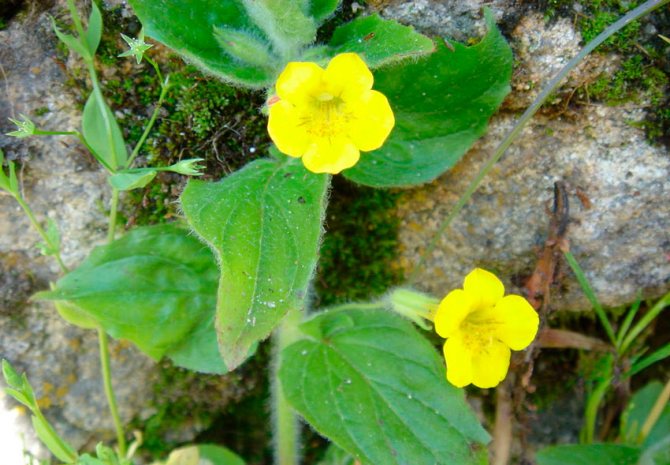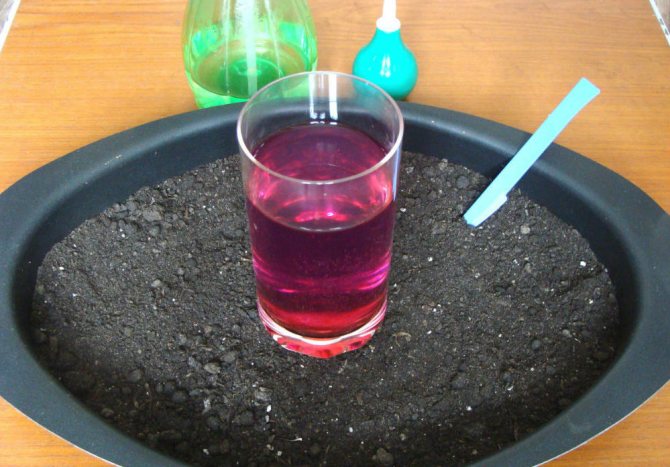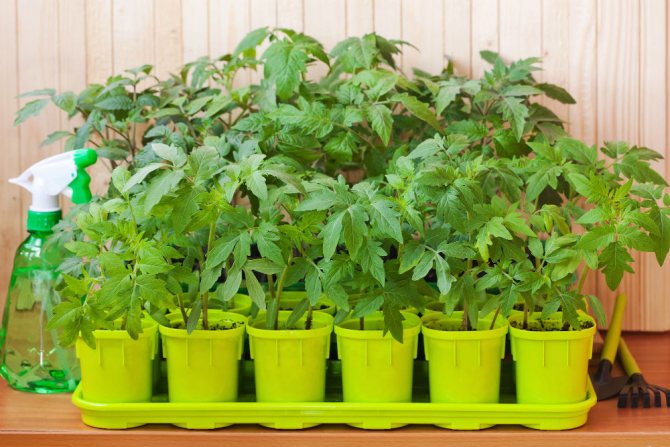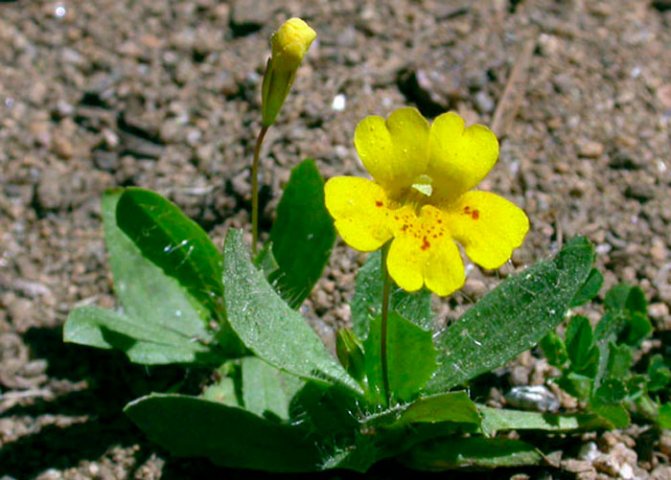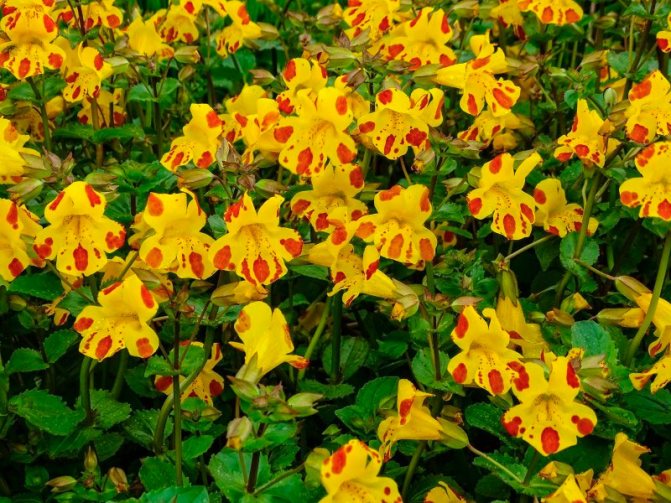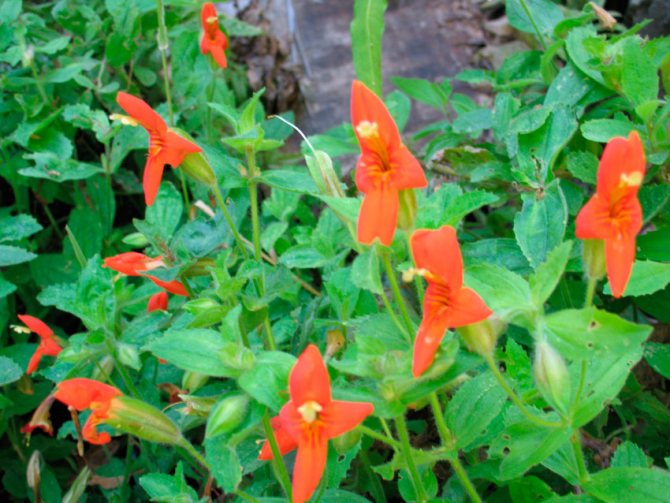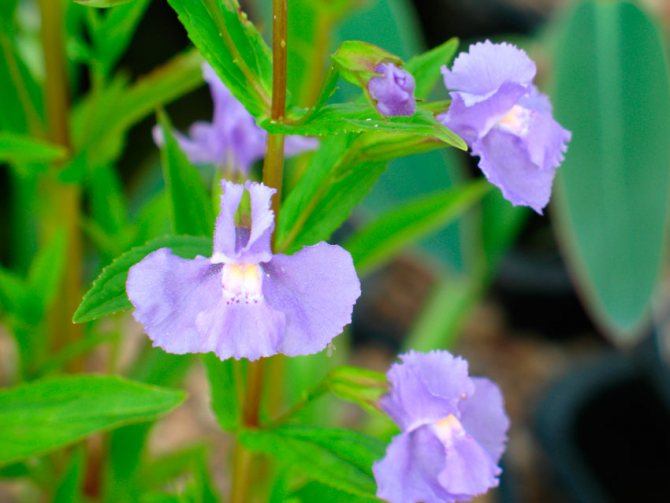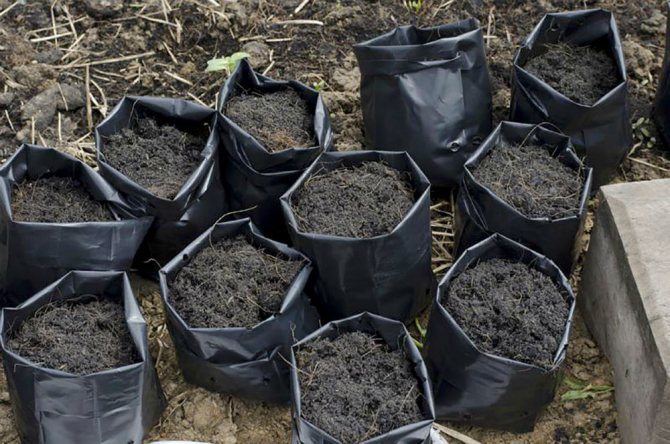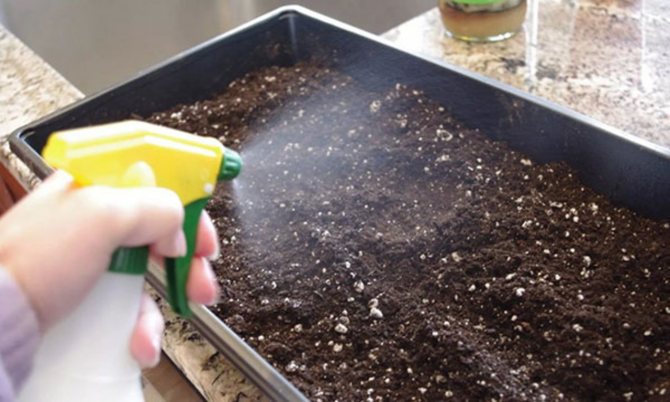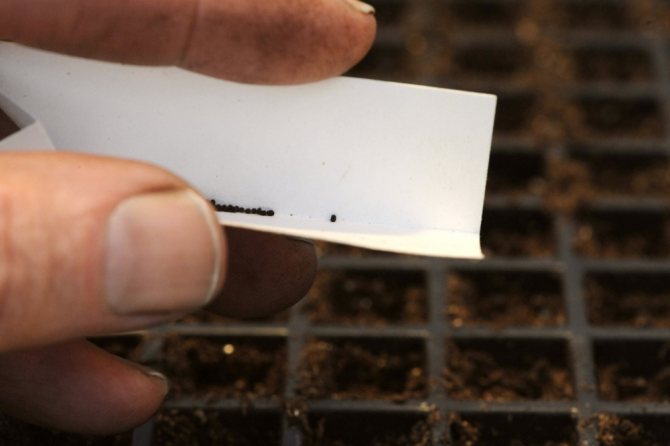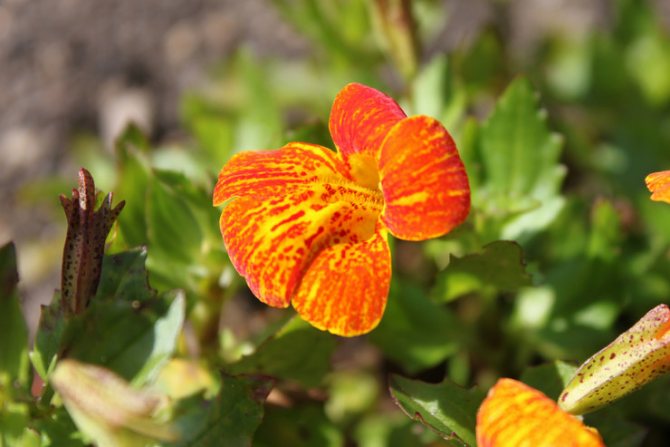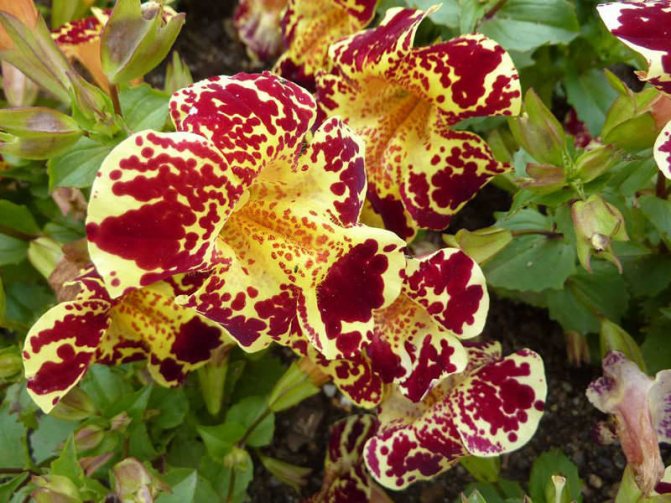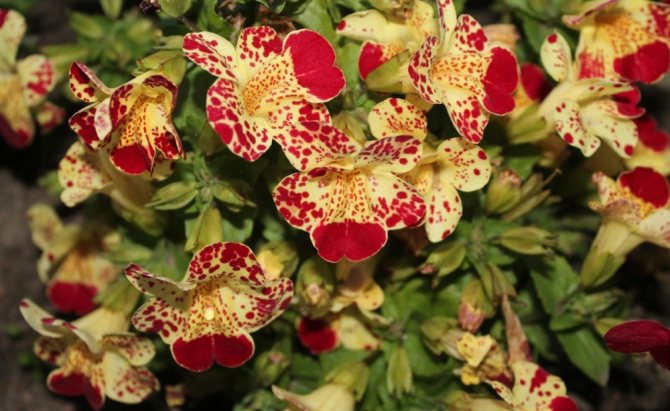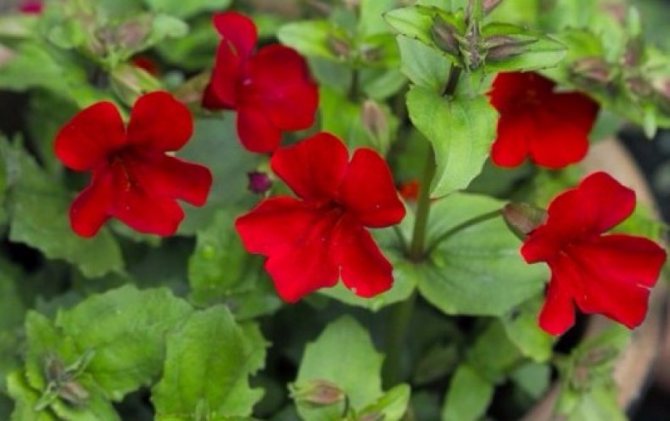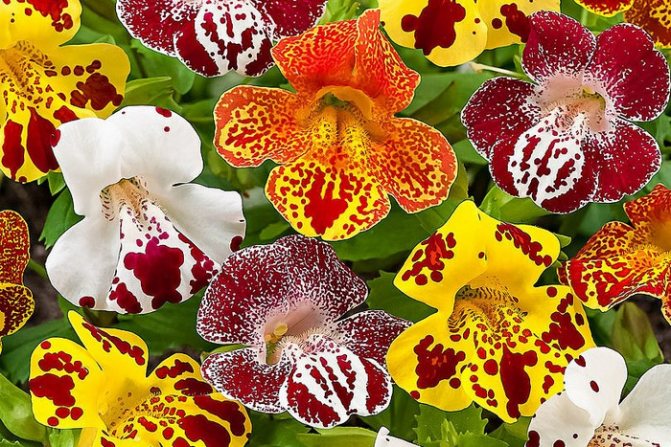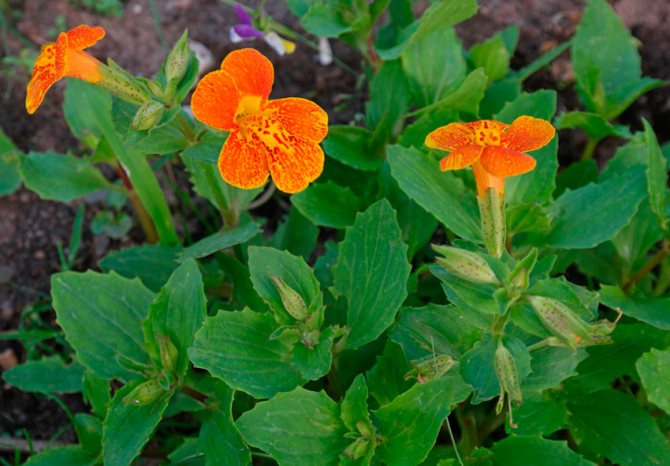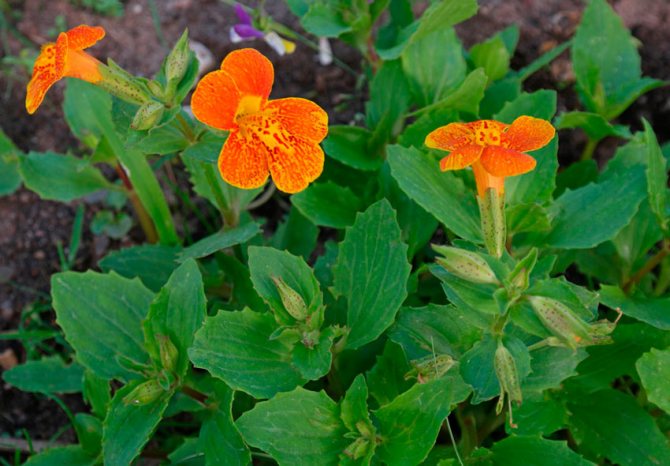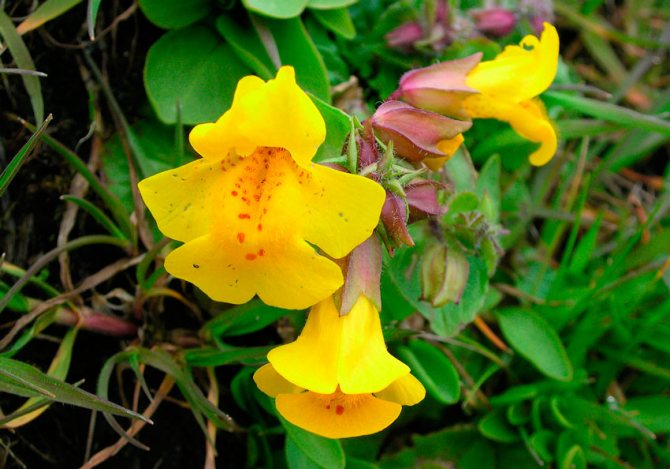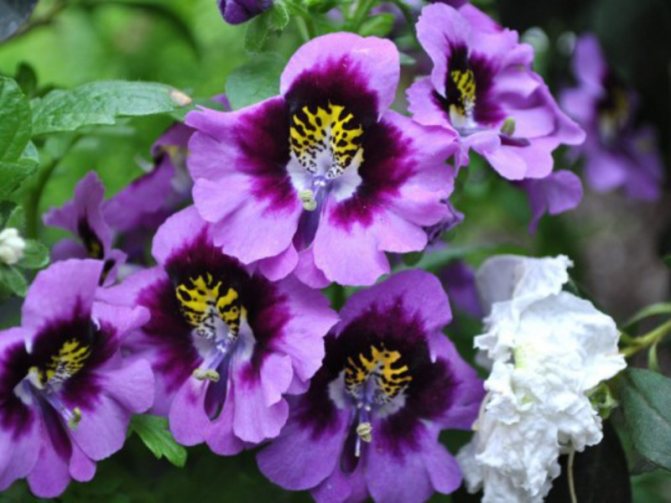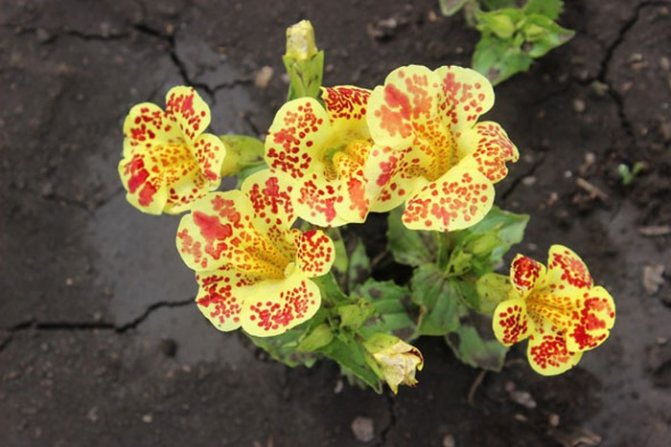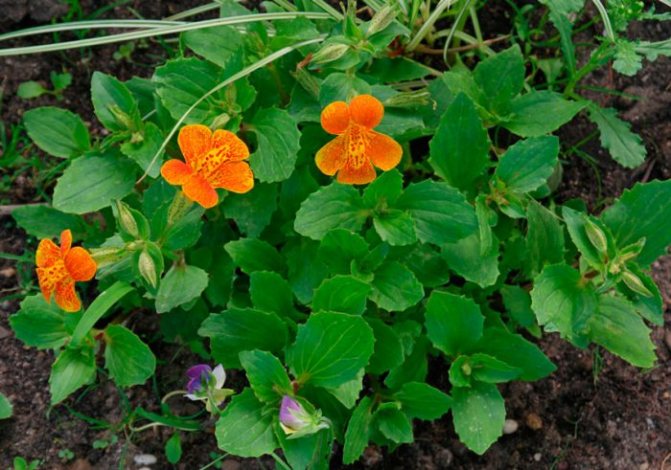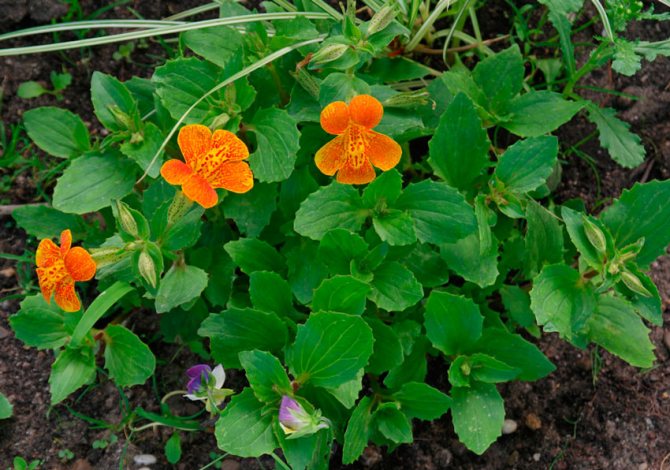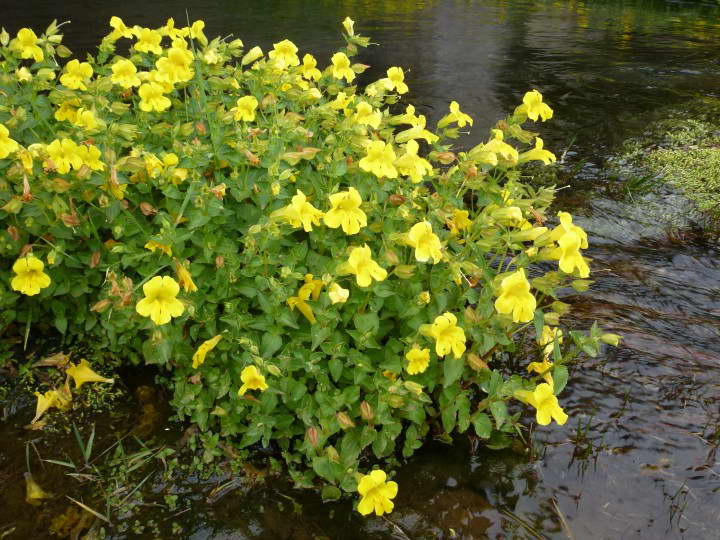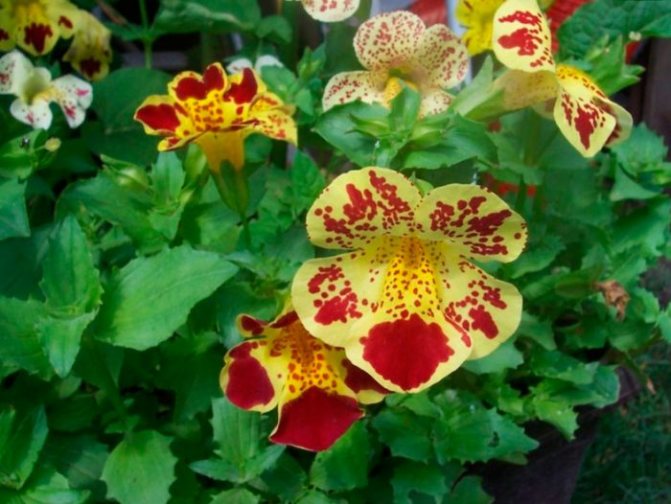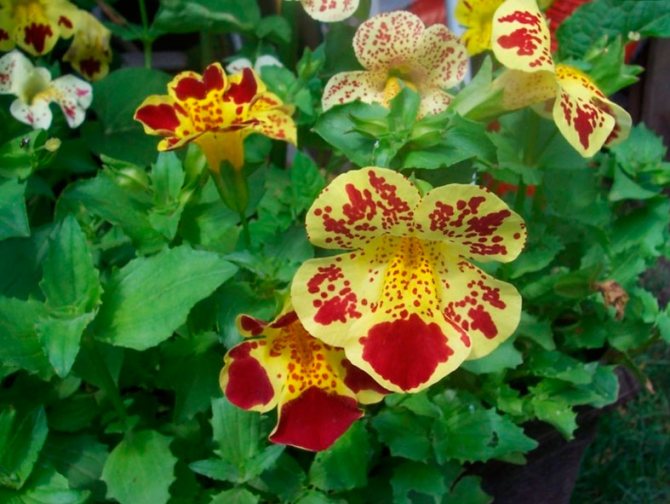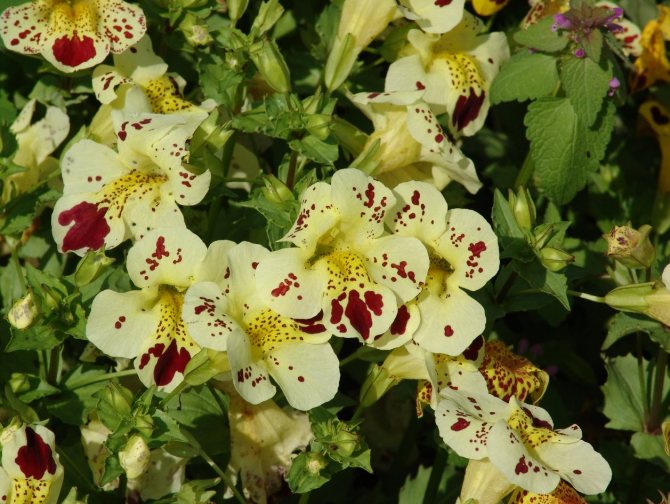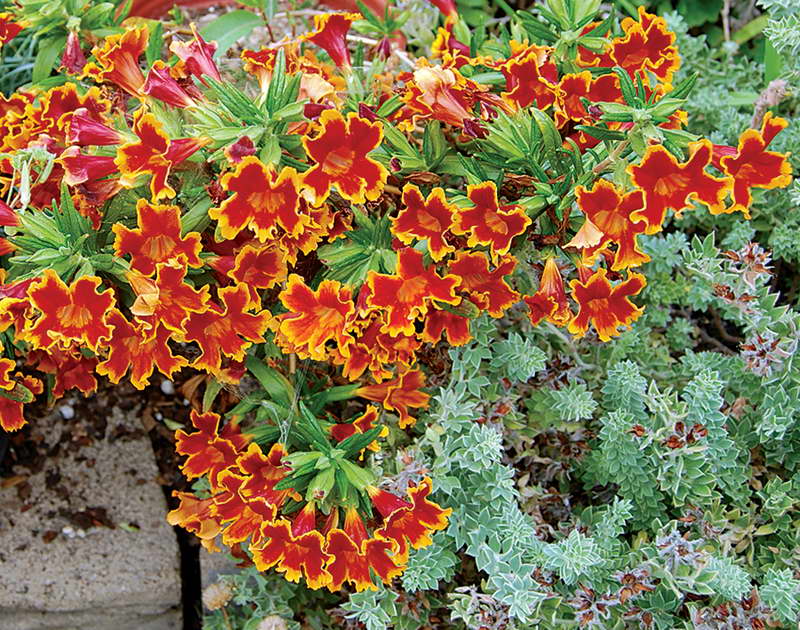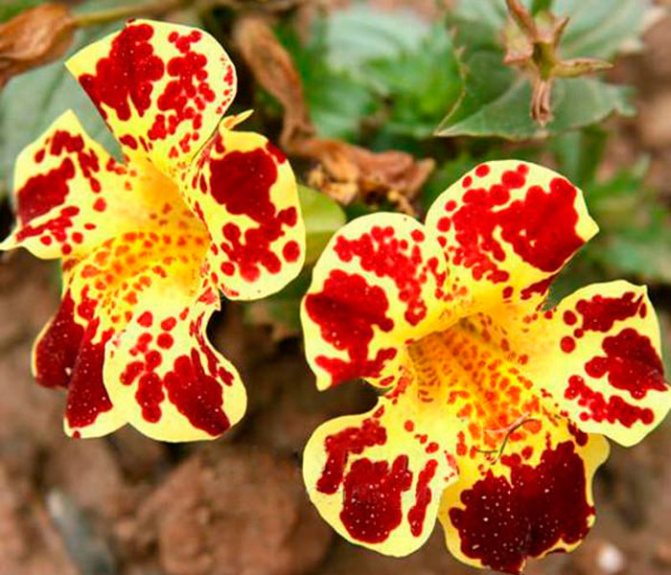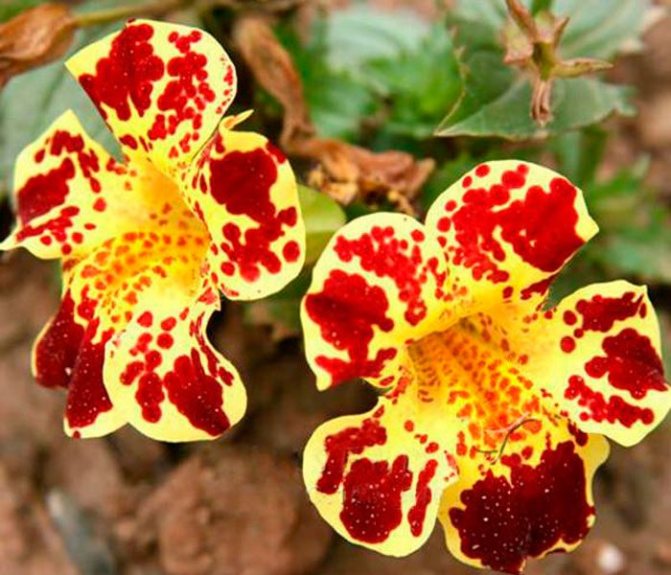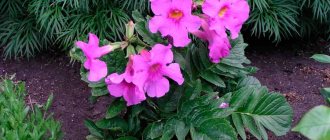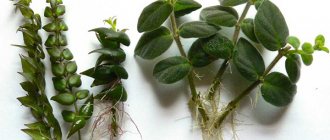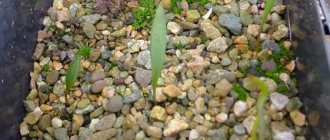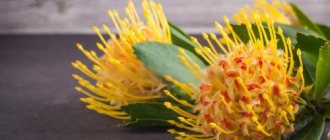Description and features of mimulus
It is a perennial plant, but in the harsh weather conditions of Russia, it is planted as an annual flower. However, there are winter-hardy varieties that can easily tolerate up to -20 ° C. The buds are of the correct shape, in a circle up to 50 mm. They have a rim, consisting of a two-lobed upper labellium, curved backward and a lower one, having 3 lobes, protruding forward. The petals are monochromatic or spotted. At the end of flowering, the fruit-box begins to form, containing medium-sized brown seeds. After ripening, it cracks into a couple of pieces.
Mimulus or lipstick
The original mimulus becomes a real decoration of flower beds. Experienced flower growers are well aware of this decorative name, which is common in our country under the name "lipstick".
Mimulus, grown as an annual, naturally grows as a perennial plant, spread from the American mainland. There the flower grew on almost the entire continent, from North to South America. Mimulus felt just as well in another part of the color - Australia, South Zealand. Where it grew, the flower chose wet and even wetlands for itself. Mimulus is a flower plant. The biological class of the family is Frim.
There are 2 types of plants:
- herbaceous mimulus - height from 10 to 70 cm;
- dwarf shrub - height up to 150 cm.
The shoots of the plant are also different. In some varieties, they are erect, in others they are creeping. Some varieties have a slight edge on the stele. The leaves are bright green, oval in shape, the edges of the leaf are serrated. On the stem, the leaves are opposite each other.
Inflorescences are collected in a cluster of 5-7 flowers. The flower at the base has the shape of a corolla, which is divided in the upper part into 2 lips: lower (3 lobes) and upper (2 lobes). The shape of the lower lip adds originality: it curves forward. The flowers reach 50 mm in diameter.
The flower is frost-resistant, reacts to drought by stopping flowering.
The timing of the appearance of flowers:
- April - July;
- September (October) (after the end of the dry season and the onset of autumn rains) - before frost.
Growing mimulus from seeds
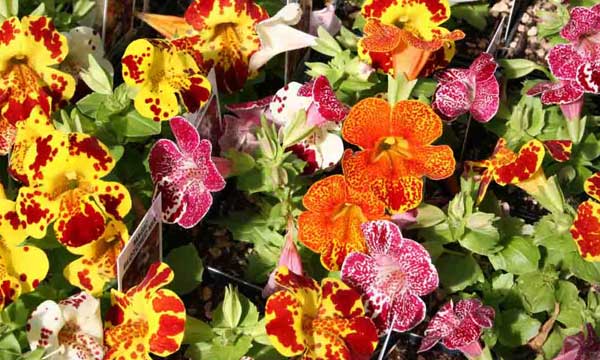
Sowing seeds for seedlings
It is necessary to sow the seeds of Mimulus no later than the beginning of April. These seeds are very small and even mixing them with dry sand will not give a special effect, thickening cannot be avoided. Therefore, you should prepare for the subsequent pick. Due to the fact that the seeds of mimulus are very small, they are not embedded in the ground, but are distributed as evenly as possible over the surface of the earth, which should be light and loose. Before planting, it must be slightly moistened. Mimulus seeds, after they have been spread on the soil surface, are also moistened with a spray bottle. Then the container with crops is covered with any transparent material to create greenhouse conditions. They must be kept in a bright place with a moderate (+ 16-18 degrees) temperature.
You will not have to wait for shoots for a long time. On average, a week. Often, the first shoots appear on the third day.
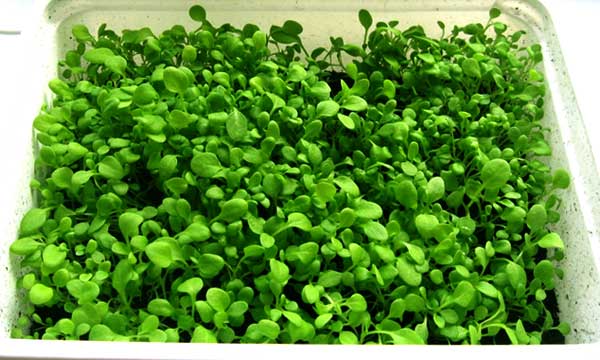

Seedling care
If the sprouts have sprouted too densely, then after a week they must be thinned out so that they do not interfere with each other's growth. To avoid pulling the mimulus sprouts, place them in a bright and cool place.When the seedlings give 4 true leaves, they can be cut into separate containers. It makes sense not to allocate a separate container to each seedling, but to plant them in groups of 4-5 pieces. When the Mimulus seedlings get stronger and take root after the dive, it can be fed with a weak potassium fertilizer.
Reproduction of mimulus seedlings
Despite the fact that the original flower in natural conditions is a perennial, it is planted annually in household plots. Planting and caring for a plant is not difficult. You can plant a flower with seeds, cuttings or seedlings.
Seedling preparation
The timing of sowing seeds for seedlings depends on the climatic zone:
For seedlings, you need to prepare a potting mix. To do this, mix 1 part of turf, peat, sand, add 2 parts of soil and 3 parts of humus. You can use the purchased mixture, which must be diluted with sand, peat, humus.
Since the seeds of mimulus are very small, they are laid shallow in the soil. The soil must be moist. Small containers are suitable containers. After planting the seeds, the containers must be covered with foil, creating greenhouse conditions, and placed in a warm place (not lower than + 18 °).
Before germination (7 days), the containers are not watered, but only moistened by spraying. To keep the sprouts healthy, you should not overmoisten the soil even after they appear.
With the first leaves formed from the cotyledon, the plants are rearranged to a cooler place (no more than + 15 °).
Seedling picking is carried out 14 days after the appearance of the second or third true leaf. Plants are carefully transplanted into cups (3-4 pcs.). In order not to damage the seedlings, the containers are watered several hours before the dive. You need to get them out of the container using a sharp object, for example, a knife. When diving, it is important to pinch the root. The planting depth is determined as follows: the growing point should be just below the soil level.
You can plant seedlings in the ground after 6-8 weeks, provided that the soil is sufficiently warmed up.
Cuttings
Good results for propagation of mimulus are given by cuttings. A stalk suitable for planting is prepared in the summer, after flowering ends. For reproduction, cut off such a part of the shoot, which has 3 or more nodes. The stalk is planted in wet sand (or a mixture of sand and peat). To create comfortable conditions for the cutting, cover the planting with a bag. It usually takes about 3 weeks to root, after which it can be transplanted into the ground.
Read also: White willow tree: photo and description, cultivation, reproduction and application
First of all, you need to choose a landing site suitable for Mimulus, in partial shade, so that young shoots do not die from the sun's rays. The soil at the planting site is mixed with peat and humus.
Transplanting
The seedlings are planted in a prepared place, leaving a distance of at least 20 cm between the shoots. So the branched shoots will not be too thickened, they will be able to ventilate, which will help to avoid soil decay.
Growing from seeds
When planting seeds in a flower bed, flowering will occur later, otherwise the development of plants will occur as well.
When the soil is warmed up and there is no threat of return frosts, seeds can be planted. It is important not to allow deepening and create a greenhouse at the planting site, covering the soil with film or glass. After the sprouts get stronger, they must be thinned out so that there is at least 20 cm between the remaining plants.
Types and varieties of mimulus
The genus includes about 150 varieties. However, only a few are cultivated.
Orange
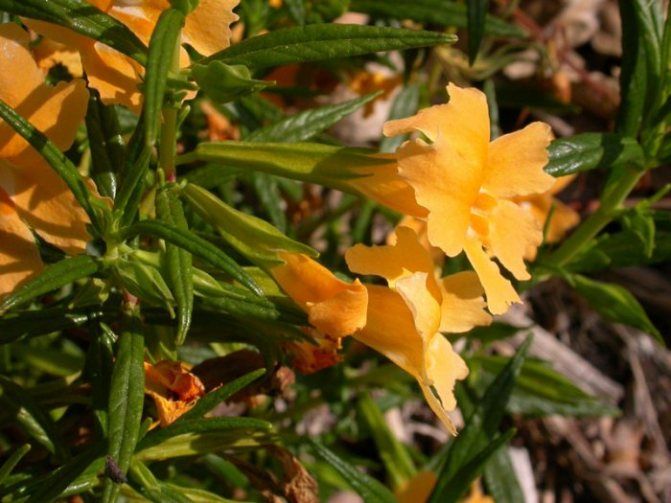

The foliage is emerald, glossy. The flowers are orange or coral pinkish. The stems need a support stick, otherwise they will begin to bend and creep. Can overwinter in a room with a low temperature.
Pomegranate
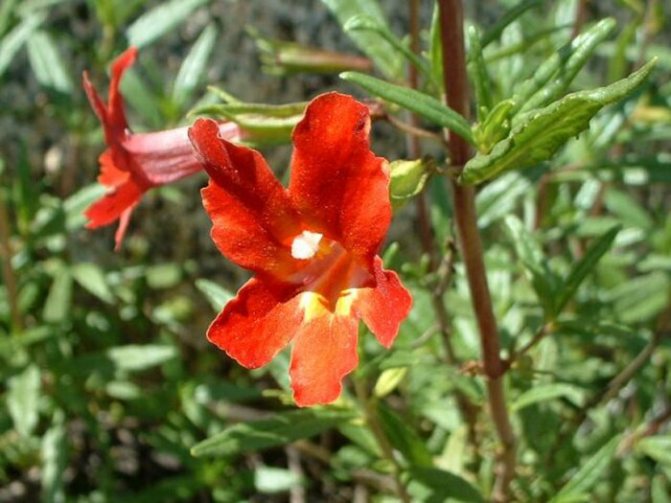

It grows in southern California and on the border of Mexico with the states. Iridescent petals, burgundy shades with an orange-colored heart.
Yellow
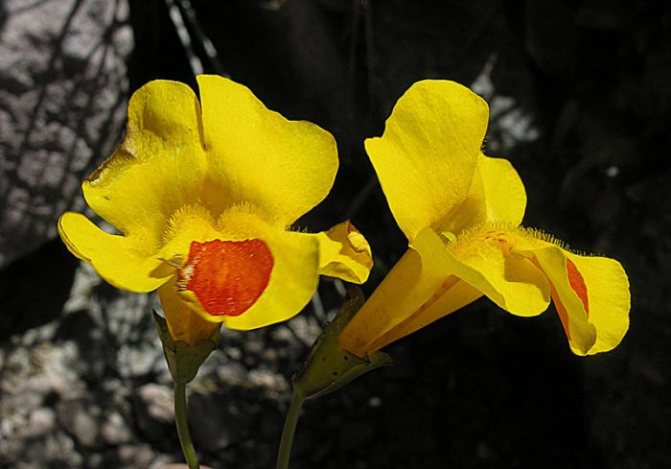

Originally from Chile. Shoots are vertical, branching, slightly pubescent, reaching 0.6 m. There are teeth on the edges of the leaf plates. Sun buds are collected in apical or axillary inflorescences. In Russian gardens, this variety is not often found.
Mottled
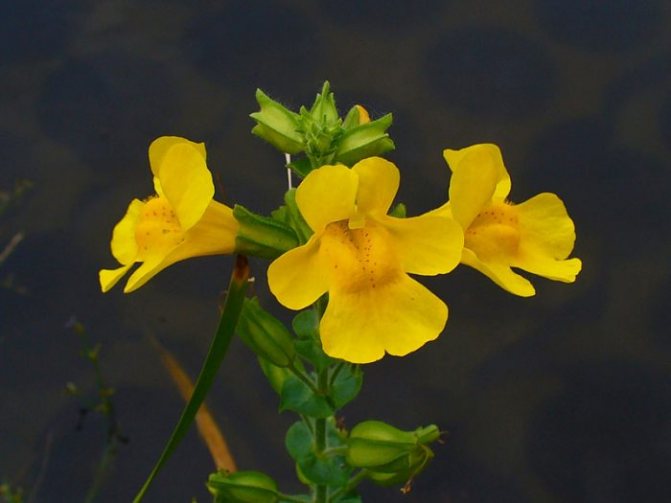

Initially, it grew only in the western regions of the North. America, eventually spread to the northern and eastern parts, New. Zealand, to some European areas. It grows up to 0.8 m. Stems are straight, branching. Lemon flowers with burgundy specks in the middle. The most famous variety is Richard Bish. It is a variegated form with grayish-malachite plates with pearl edging along the perimeter.
Red (purple)
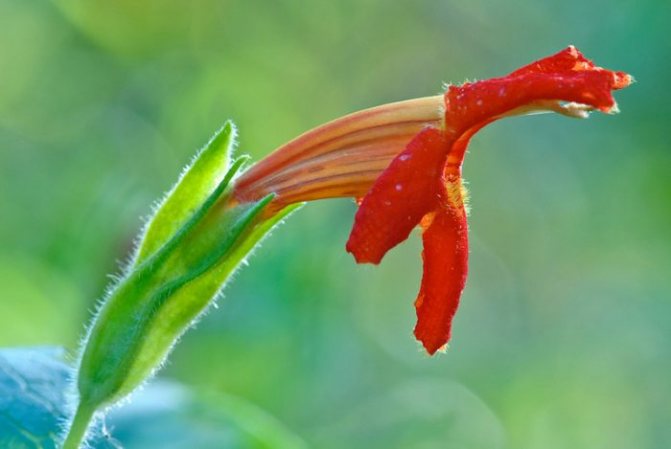

The stems are pubescent, branching immediately from the base. The red or purple lipstick has ovoid leaves with teeth and protruding veins. Scarlet buds are located on elongated pedicels in the axils of greenery. The following varieties are planted in Russia:
| Name | Flowers |
| Auranticus | Reddish red. |
| Cardinal | Fiery crimson with yellowish splashes. |
| Rose Queen | Large, pudding with dark patches. |
| Red Dragon | Pomegranate. |
Copper red
Stems are bare, slightly erect. The buds are located on shortened axillary pedicels. At the beginning of flowering, copper-colored or reddish. Over time, they acquire a golden canary color. Common varieties:
| Name | Flowers |
| Red Imperar | Bright, crimson. |
| Andean Nymph | Beige, with soft lilac specks. |
| Rother Kaiser | Scarlet. |
Primrose
Consists of thin shoots reaching 15 cm. Greens are ovoid or oblong. Lemon flowers grow on developed pedicels. The only variety that can winter outdoors.
Musky
Herbaceous plant with pile on shoots and foliage. Produces mucus and exudes a musky scent. Spreading shoots or erect-erect, up to 30 cm. Leaves are oval. Canary buds, up to 25 mm in circumference.
Gaped (uncovered)
Branching stems, rounded leaf plates. The flowers of the open mimulus are small, pale lilac.
Tiger
It also has other names: leopard, hybrid, large-flowered, maximus. This species includes all varieties obtained by crossing mimulus yellow and speckled. Tiger lip grows no more than 25 cm. Multi-colored buds. This is a very popular variety among flower growers. The following varieties are especially popular:
| Name | Flowers |
| Foyer King | Reddish with brown blotches and a yellowish core. |
| Sun in the shade | Various tones. |
| Viva | Canary, with large burgundy spots. A distinctive feature is early flowering. |
| Magic Spots | Snow-white beige, with raspberry splashes. |
| Magic Mix | Solid or bicolor with pastel petals. |
| Twinkle Mix | One color or several. There are different tones: from pearl to rich crimson. |
| Brass Mankis | Speckled, bright rusty. |
Common types and varieties of mimulus
Mimulus belongs to the Norichnikov family. The homeland of the flower is North and South America, Australia and New Zealand, where the plant is found in the wild in humid, swampy places to this day. In nature, Mimulus bloom in spring and autumn, and in summer, during a drought, they are at rest. The genus Mimulus includes more than 150 species of annuals and perennials. The stem can reach a height of 70 cm, there are erect and creeping species. The color of bell-shaped flowers is yellow, red, orange, but most often varieties with a variety of spotting are found. In place of the flower, after successful pollination and flowering, a fruit-box with many very small seeds is formed.
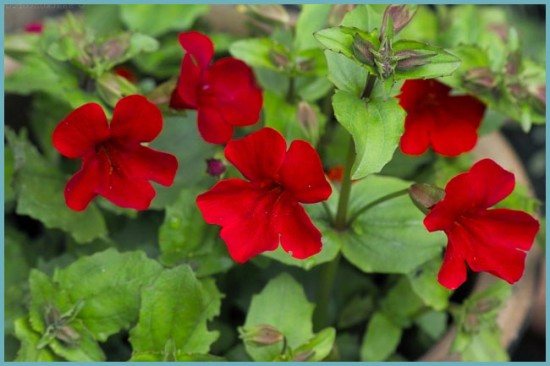

Mimulus red
Mimulus is red. Bushes rarely reach 40 cm in height. However, a perennial is more often grown as an annual crop. The flowers are fragrant, monochromatic, fiery red. As a result of selection, varieties with pink flowers "Rose Queen", "Cardinal" and large burgundy flowers "Red Dragon" were bred.
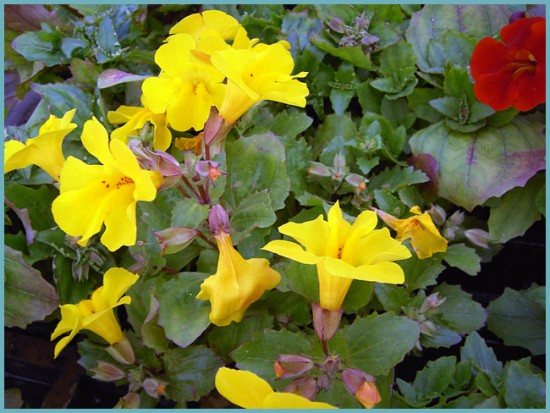

Mimulus yellow
Mimulus is yellow. A perennial plant, but cultivated as an annual. The height of this species is 60 cm, the stems are slightly pubescent.
Read also:
16 excellent varieties of plums for the Moscow region
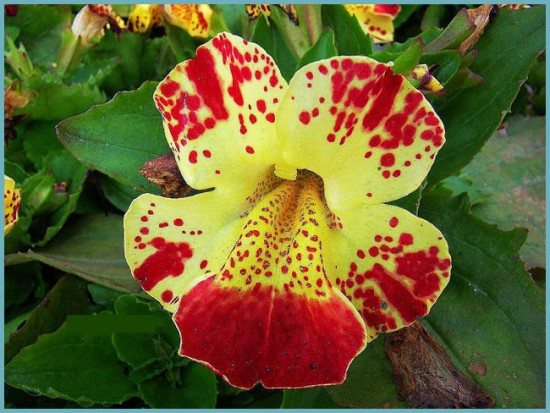

Mimulus tiger
Mimulus is tiger. Low - up to 30 cm - a perennial plant. Can grow at home. This species has many different shapes and colors. The flower of mimulus tiger is somewhat reminiscent of snapdragon, but only larger in size. Large bright red spots are located on yellow petals. As a result of selection, varieties with orange flowers were bred ("BrasMankis" variety). They amaze with their endurance and early flowering of the variety series "Magic", "Viva" and "Calypso".
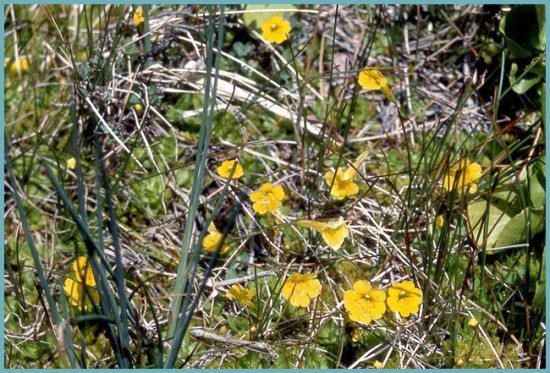

Mimulus primrose
Mimulus primrose... A perennial plant, but, like other species, it is used in the garden as an annual. The height of the bush is only 15 cm. Delicate flowers are located on long peduncles and have a pale yellow color. Flowering lasts from July to September.
Where did the lipstick come from?
In the wild, this flower can be found on different continents. True, he mainly lives in North America.
It is curious that the wild mimulus likes damp lowlands, deserts, and even mountains (some species of a flower were found at an altitude of 2.5 thousand kilometers above sea level).
The genus of Mimulus is very extensive, it includes more than 150 species. The names of these species are very simple (red, yellow, brindle mimulus). Each popular species has many varieties (for example, red can be "Red Dragon", "Cardinal", "Rose Queen").
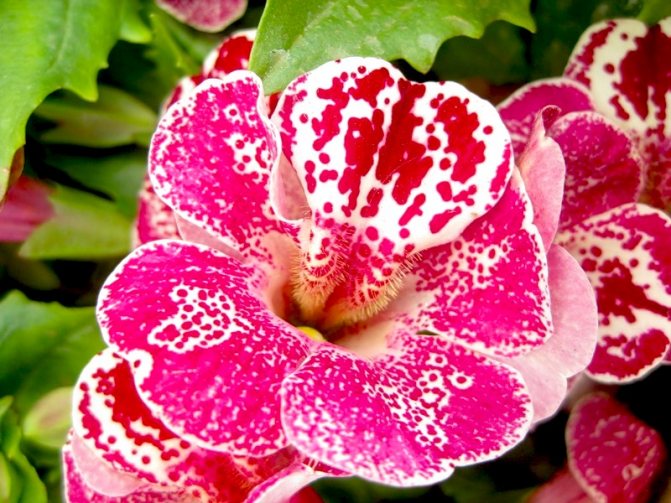

Where is it grown with us
Mostly outdoors. It can be flower beds, and rock gardens, and even hanging pots.
Some people also successfully grow the flower in balcony boxes. In this case, it can be grown in splendid isolation or combined with flowers such as mattiola, verbena, lobelia.
"Free" is a perennial, but in our climate the lipstick lives only one year. There are several frost-resistant species that are not afraid of dropping temperatures to -20 degrees, but this is rather an exception to the general rule.
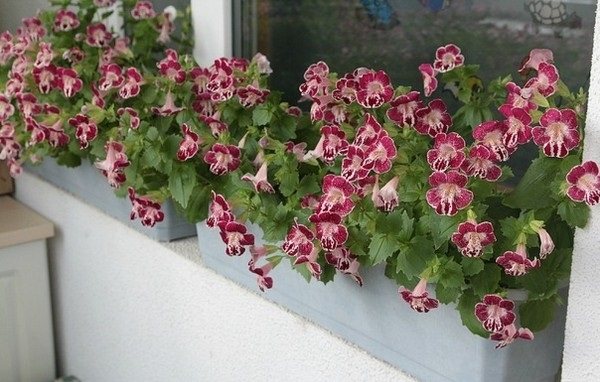

A short description of such a flower
- Depending on the species, it is either a herbaceous plant (up to 70 cm), or a half-meter shrub.
- Its branches can be either pubescent or bare; they can travel on the ground (ground cover species) or grow upright.
- The leaves of the flower are ovoid, grow in pairs, one opposite the other.
- Flowers are medium in size (up to 5 cm), irregular in shape. Their petals can be either spotted or completely monochromatic. The inflorescence really resembles a sponge, with the upper one being dicotyledonous, and the lower one being three-lobed.
- The plant blooms profusely, delighting with its flowers 2 times per season. Flowering duration: several weeks.
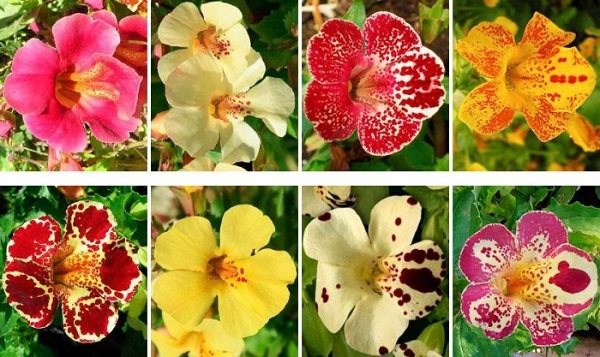

Growing mimulus from seeds
Sowing is carried out:
- in boxes for seedlings;
- into the ground to the street.
The first option is preferable, since with the second method, the bushes begin to form buds only by August or September.


Sowing
Sowing in pots is carried out in the 2nd decade of March or the 1st half of April:
- Prepare containers with an airy substrate with medium acidity or peat tablets. A universal nutrient soil mixture containing coconut fibers and perlite is suitable. You can buy it at any specialty store and add sand there yourself.
- Spread the seeds over the surface by mixing with coarse grains of sand. Because the seed is fine, it will not work evenly. Therefore, in the future, a pick will be necessary.
- You do not need to cover it with earth.Just moisten with a spray bottle.
- Cover with plastic or glass to create a greenhouse effect. Remove the cover daily to ventilate, remove condensation and humidify from a sprayer with a fine nozzle.
- Place the container in a room with good lighting. The optimum temperature is + 15 ... + 18 ° С.
- Shoots can be observed after a couple of days.
Growing seedlings
After the appearance of most of the sprouts, the container must be rearranged to a temperature of + 10 ... + 12 ° С. This is necessary so that young shoots do not begin to stretch. Watering is carried out daily, preferably in the late afternoon. Spray regularly with a fine spray bottle. After the beginning of the formation of the fourth true sheet, make a pick into separate containers. Transplant 3-4 shoots into each pot. After a few days, when the plants will adapt to the new place, add the potassium mixture in ½ the dosage indicated on the package. Re-feed after 7-10 days.
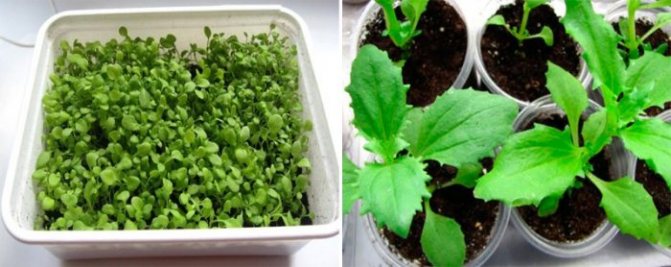

Planting mimulus in the garden
2 weeks before disembarkation, the seedlings need to be hardened: take them outside daily. Start at 15 minutes, gradually increasing the time. When sowing directly into the garden, the seeds do not need to be buried in the substrate. It is enough to cover with foil until shoots appear. When they get stronger, remove the shelter and thin out the shoots.
The timing of planting seedlings and seeds in open ground
The optimal time is the second half of May and the first decade of June. When the probability of frost return disappears and the earth will completely thaw out. In the southern regions of our country, planting is carried out in the second half of April. This can be done provided that the average daily temperature was + 15… + 18 ºС for several days.
Landing technology
Gubastic grows well in partial shade and in open areas. However, in strong sunshine, greens can wilt or burn. Choose a loamy land, with a sufficient amount of humus and peat, low acidity. Phased disembarkation:
- Dig up the site, level it, moisten it abundantly.
- Dig holes of such a size that the rhizome of the bush will fit together with an earthen lump. Leave 20-30 cm between them.
- Water the soil mixture in pots to make it easier to pull out the shoots.
- Move the seedlings using the transfer method.
Four steps to mimulus
We sow the lipstick
Plant Diastia photo, species, growing from seeds, planting and care in the open field
Sowing mimulus seeds is best done between May and June. However, if it is planned to grow a plant for a commercial purpose, then the optimal period will be July-August. The lipstick or mimulus has extremely small seeds. One gram of seeds contains from 22,000 to 30,000 seeds. To make sowing more convenient, they are sold in flower shops in the form of granules or peeled.
In order to grow beautiful flowers, mimulus is sown in a loose soil or substrate that does not contain fungal infection, with a low salt content and an acidity level in the range of 5.5-5.8 pH.
Seedling cassettes
After sowing in open ground, both normal and granular seeds, they are either left as they are or sprinkled with vermiculite. It is recommended to sow seeds in special sowing boxes, which it is desirable to cover with glass, and the cassettes themselves, respectively, with a covering material. The technologically correct process of sowing seeds advises to sow Mimulus in so-called sowing cassettes, in each cell from one to three pieces.
For those who are not yet familiar with seedling cassettes, we suggest looking at the photo above.
We observe the growth
The sown granulated seeds require soil for growth, the temperature of which is in the range from 18 to 23 C. Moistened soil is also required. Subject to these conditions, the first shoots of mimulus can be observed in the period from two to seven days.After the unfolding of the cotyledon, cassette, or sowing, it is necessary to transfer to a cooler place in which the ambient temperature is in the range from 15 to 18 C. It is also necessary to reduce the intensity of irrigation. It is during this period that the cultivation of mimulus becomes as responsible as possible. In other words, the soil should be constantly moist, but not so much that the strayed plants die from decay or "black leg".
We monitor optimal growth conditions
As soon as the sown seeds have a real first leaf, they should be fed with potassium and nitrogen in a ratio of 14: 0: 7 or K: P: N. As for the dosages, they should be as follows: 0.0005% - 0.00075%, or from 50 to 70 ppm. The use of ammonium nitrogen is not recommended. After the appearance of the second or third leaf, the dose of dressing should be increased to 0.001 or 0.015%, or from 100 to 150 ppm. In turn, the soil temperature should not exceed 16 C. If the temperature is too high, the mimulus will begin to stretch.
Taking care after transplant
In the dominant number of cases, plants of succulent mimulus infect slugs and snails. Invasion will be inevitable in case of excessive moisture. Among the diseases of mimulus, powdery mildew is also common. In order to protect the plant, which was so persistently grown from seed, from possible pests, it is necessary to take appropriate protective measures. However, the plant is quite persistent and practically does not get sick.
When roots appear from the bottom hole of the seed cassettes, it means that the mimulus is ready to be transplanted into larger seedling cassettes: from 7 to 9 cm, or ten centimeter pots.
Flowering mimulus
After transplanting into larger pots, potassium and nitrogen fertilization should not stop. The ratio will be 1: 1: 5 during this period, the dosage is 0.002% or 200 ppm. If the soil is oversaturated with nitrogen, the stretching of the stem of the plant will increase in case of dominance of high temperatures. In order to increase the abundance of flowering, it is necessary to feed Mimulus with magnesium sulfate one to two times at a dosage of 0.025%. In order to enjoy the plant for a long time, as shown in the photo, it is better to use the seeds of hybrids, which need a long day to bloom. In this case, Mimulus will perfectly lay buds at twelve or fourteen hours a day.
If you dream of a compact plant, experienced gardeners recommend growing mimulus in a lot of light, but shade the seedlings themselves in the summer.
Growing mimulus from seeds
Sowing mimulus
When to sow Mimulus at home? Sowing mimulus seeds for seedlings should be in late March or early April. Due to their small size, you will not be able to distribute them evenly over the surface of the substrate, therefore it is impossible to grow sponges with seedlings without picking. As a substrate for seedlings, you can use a universal soil with coconut fiber and perlite, adding a little clean sand to it: the main thing is that the substrate is light and loose. The seeds are not embedded in the soil: they are moistened with a spray bottle, the crops are covered with transparent film or glass and kept in a bright place at a temperature of 15-18 ºC. Under such conditions, mimulus from seeds will begin to germinate in 2-3 days.
Mimulus seedling care
After the mass emergence of seedlings, the seedlings of mimulus can stretch out, and to prevent this from happening, it will be necessary to lower the temperature of the content to 10-12 ºC and place the seedlings in the brightest place. Watering of seedlings is carried out daily in the afternoon, seedlings respond well to spraying from a fine spray. At the stage of formation of 4 true leaves, the mimulus is picked in separate cups: 3-4 seedlings are planted in each.After the mimulus recovers from the pick, you can feed it with potassium fertilizer in a weak concentration. The second feeding is carried out after 7-10 days.
We dive the plants correctly
Blooming mimulus at home
It is not difficult to achieve such a result as in the provided photo, if all the necessary growing conditions are fulfilled. Therefore, a few hours before picking seedlings, it is watered abundantly. The transplant is carried out by prying with a pencil, a flat thin stick, but it is better to use a special spatula. It is necessary to hold the seedling not by the leg, but by its cotyledonous leaves. The seedling is carefully removed from the soil and the central root is cut off by two-thirds or up to half. This will allow the lateral roots to nudge development. A small depression is made in the "new" soil, into which the mimulus is planted to the level of the growth point, or somewhat lower. This fit will allow additional roots to form. Also, in the future, this will allow the plant to more easily transfer the transplant to a permanent place, as well as to grow more quickly.
Mimulus care
Gubastic is easy to grow from seed and keep. However, in order for it to bloom magnificently and not get sick, the following simple rules must be followed:
| Factor | Recommendations |
| Watering | Regular, especially in hot, dry weather. The top layer of the earth must always be moist. When small holes appear on the plates, this indicates that the number of irrigations must be reduced. |
| Top dressing | Apply potassium-phosphorus fertilizers under the base every 4 weeks (for 10 liters of water, 15 ml of the mixture). Feed additionally after pruning. |
| Loosening and weeding | Produce after each watering. |
| Trimming / pinching | The bush blooms twice a season: in spring and early autumn. After the first wilting of the buds, cut off the inflorescences. Soon new shoots will grow, the secondary flowering will be more colorful. It is necessary a few weeks after planting for a greater splendor of the bush. |
| Transfer | Needed for indoor growing specimens. Produced twice a year: in early spring and summer, between flowering periods. |
Proper care of mimulus in a flower bed
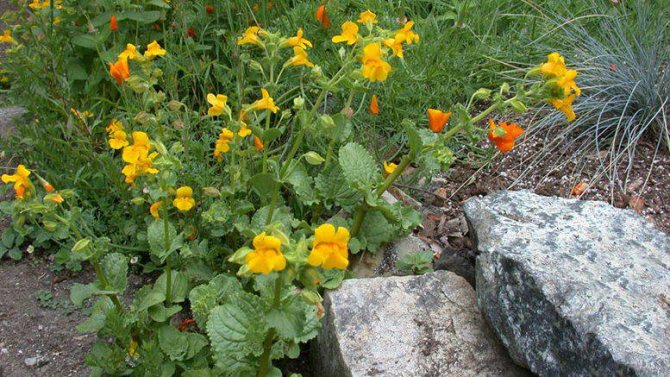

Watering
Water the mimulus daily to keep the soil from drying out. Water in the afternoon or evening. Plants are hygrophilous, in the heat they especially need water.
Do not allow the soil to become waterlogged, otherwise the mimulus can get sick. Watch the plants, increase the amount of water if they are lethargic. If small holes appear on the leaves, water the flowers less vigorously. Water the whole summer using warm, settled water.
Top dressing
Mimulus need feeding, spend the first on the 3rd week after planting in the ground. Then they are fed every 30-45 days. Use mineral fertilizers for ornamental plants. A bucket of water (10 l) will need 15 ml of the finished solution. It is not recommended to use formulations with a high nitrogen content, otherwise the stems will be very elongated.
You can additionally fertilize mimulus with magnesium sulfate, the plant will bloom more abundantly. Fertilizer is also used if flowers do not appear for too long. Magnesium sulfate is applied 1 or 2 times, 20 g of fertilizer will be required for 10 liters of water.
Loosening, mulching
Loosening is desirable after each watering, while removing weeds. It is better to cover the soil around the flowers with mulch. The layer of material will depend on the soil: on loams it should not exceed 2 cm, on sandy loams - 3-6 cm.
The mulch should not touch the stems, otherwise they can rot. You can use the following types of material: pine needles (preferably pine), fallen leaves, wood chips, humus, peat, straw, sawdust. For a rock garden, fine gravel is suitable as mulch.
Pinching
In Mimulus, it is necessary to pinch the tops so that the plants branch well. This is done as early as possible, before bud buds appear.In the future, it is necessary to remove drying shoots, this will stimulate flowering. The formed bushes are denser and more elegant, more flowers appear on them.
Orange Mimulus (Mimulus aurantiacus)
Growing in the southwestern United States, Mimulus orange is accustomed to heat and sun, so it will not withstand low temperatures and shade. This is a tall plant - up to 1 m. At this height, it is very difficult for the shoots to grow upward, therefore, without supports, they begin to grow in different directions and spread along the ground. It blooms with bright orange, salmon pink flowers (petals with red tints can also be found). The flowering period is May-September.
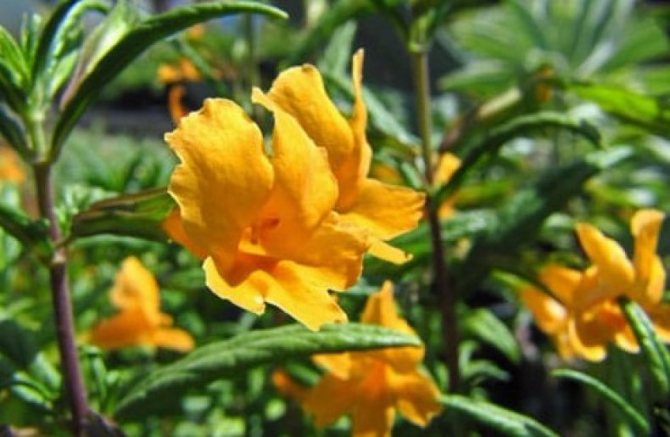

Diseases and pests
Gubastik is a hardy and healthy plant that is rarely affected by diseases and insects. However, with immature shoots, problems may arise:
| Disease / pest | Signs | Control measures |
| Blackleg |
|
|
| Powdery mildew |
|
|
| Gray rot |
|
|
| Gastropods |
|
|
| Aphid |
|
|
| Whitefly |
|
|
Possible growing problems
Growing a beautiful flower is not difficult if you follow it correctly. But every gardener should be prepared for the fact that diseases and pests can infect Mimulus.
- Common pests are slugs, aphids and whiteflies. Insecticides work well against them.
- The flower can be affected by gray rot, black leg and powdery mildew. Fungicides help with ailments.
- Slow growth, lack of flowering or a small number of inflorescences, yellowing of the leaves or the appearance of holes on the leaf plate are signs of improper plant care.
Mimulus is a rather simple and unpretentious flower, but so bright and unusual. They fall in love with him at first sight. The monkey flower is an ideal decoration for the garden, flower beds and rock garden.
Mimulus pomegranate (Mimulus puniceus)
Mimulus pomegranate is a native of Southern California. At home, it grows on the slopes of the hills. It has a red, dark red color with an orange inner part of the corolla. Blooms from late spring to early autumn. The plant is quite tall - it grows up to 1 m. It loves heat very much - it does not tolerate even a slight frost down to -5 ° С. It can grow both in the sun and in light shade. Drought-resistant. In addition to planting in open ground, it is used in pot culture.
Read also: Hawthorn honey: useful properties and contraindications
Application in landscape design
Mimulus is good for decorating small flower beds and flower beds. Often used as a container plant in garden and balcony planters or hanging planters. Due to its moisture-loving nature, mimulus is popular among owners of garden ponds - it is used to decorate the banks in flooded areas.
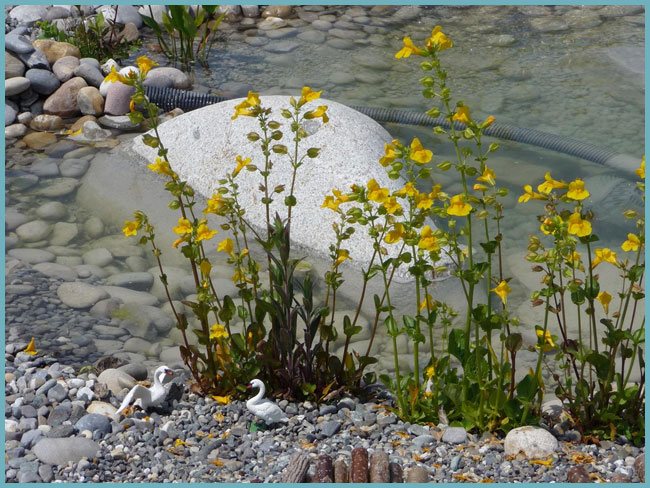

Mimulus on the shore of the reservoir
In balcony drawers, mimulus goes well with lobelia and verbena. And by planting it in a Matthiola tub, you will get a flower garden with an incomparable aroma. In the open field, mimulus, as a representative of shade-tolerant plants, goes well with decorative leafy hosts, flowering astilbe and rush. In the rock garden it looks beautiful with saxifrage, periwinkle, young, buttercups and viola.


